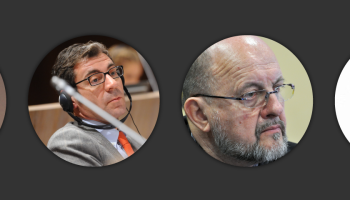Lejla Kablar, author of a 2011 report by the Organization for Security and Co-operation in Europe (OSCE) on “Trafficking in Human Beings for the Purpose of Labor Exploitation,” says that when human trafficking emerged in the Balkans, the profile of the trafficking victims was determined by the presence of foreign soldiers and aid workers. Far from their families, these men were willing to pay for sex that trafficking victims were forced to provide.
But the crime has changed in response to new socio-economic conditions, law enforcement strategies, and political situations.
OSCE Trafficking reports as far back as 2009 chronicle the changes. “Today, the typical victim of trafficking is often a citizen of the country where traffickers offer their services and below the age of 18 “ the report reads. Trafficking is carried out by “single or small groups of individuals… More often than before, the perpetrators resort to secluded locations, such as apartments and holiday homes.”
The OSCE report also cites case studies that show how traffickers exploit the age, mental state, illness, poverty and lack of family support of victims. These show the extent of physical, mental, and sexual abuse that victims endure under the noses of their families, neighbors, and law enforcement.
The one thing that has not changed is the scope and profit of the crime. “Trafficking, as an international phenomenon, knows no borders, nationality or religion.” The International Labor Organization (ILO) estimates that about 21 million victims of forced labor, including the sexually exploited can be found today.
Evolution of Balkan Trafficking
Kablar said that in the 1990s Eastern European women were tricked into leaving their countries by promises of legitimate work abroad. Many were kidnapped or sold by their families. They frequently came from extreme poverty, and were kept in bondage by physical and psychological violence, as well as by threats against their families. In addition, they were taken to foreign countries where, at the time, no effective measures were in place to help trafficking victims.
All this required organized crime networks operating across borders, and division of roles within the organization. Some members were assigned to finding and luring victims, others with making counterfeit travel documents and fake job offers for them, transporting them across borders, and delivering them in destination countries. There, the women were sold on modern-day slave markets to local criminal groups who forced them into prostitution in nightclubs and brothels.
These slave markets and brothels were well known to the public, and Eastern European women became the symbol of human trafficking in the region.
Then with expansion of the European Union, the Balkan nations faced increased pressure to protect their borders, to cooperate to limit trafficking, and to bring anti-trafficking laws up to international standards, Kablar said.
The ratification of the Palermo Protocol (full name is the Protocol to Prevent, Suppress and Punish Trafficking in Persons Especially Women and Children) in the early 2000s by several Balkan countries was an important step. This supplement to the UN Convention against Transnational Organized Crime spelled out what trafficking meant and what to do to quell it.
But, as law enforcement in the region got better at detecting and preventing trafficking across borders, criminals shifted to local victims.
The ironic consequences are that now many who see it, may not even realize they are witnessing human trafficking, or if they do, are reluctant to report it. The OSCE report says people fear retaliation by the traffickers, or heed cultural views about “minding one’s own business.”
To Combat Trafficking
Police actually need citizen reporters more than ever now that trafficking is more hidden.
Educating the public on recognizing human trafficking is important, non-government and government institutions in the Balkans agree. Kablar said raising awareness of the consequences trafficking has on its victims and on society is crucial.
Marija Andjelkovic, president of the NGO Anti-trafficking Action (ASTRA) in Belgrade, said high school-age children are especially vulnerable and need to know about trafficking. She said victims in Serbia are local, much younger than before, and that trafficking for the purpose of labor exploitation is becoming more prevalent. Frequently, as in BiH, children are being forced to beg on the streets and in restaurants, and they are often sexually exploited or threatened with sexual exploitation if they refuse to beg. Many are also forced to collect recyclable materials from trash, or to steal.
Protection of Roma children in the region is especially complicated. Authorities are reluctant to address cases of Roma child exploitation, and many citizens have a passive, racially colored attitude about the whole matter. They see begging as a “custom” of the Roma and because traffickers in these cases are frequently relatives, the authorities don’t want to get involved.
Kablar said she found that Roma children frequently are kept out of schools, making it even harder for them to find legitimate work as adults. Too often they become exploiters themselves. This keeps a cycle of poverty and cultural prejudice going.
Getting at the Root Causes
Poverty drives trafficking. As the global economy has deteriorated, more people are willing to work in bad conditions and to accept risky and shady job offers. Increasing rates of unemployment and cost of living persuade people that any job is better than no job. Some travel to foreign countries and end up doing hard physical labor without compensation. Women in these situations are frequently sexually exploited as well, said Kablar. She and Andjelkovic note that the organizers of such exploitation are more often than not from the same country as the victims. Astra consults on job contracts with Serbian citizens considering working abroad, to safeguard against work exploitation.
BiH’s State Coordinator for Combating Trafficking in Human Beings and Illegal Migration Samir Rizvo said people are often forced to work in substandard conditions, and this makes it hard to separate trafficking for labor exploitation from poor working conditions in general.
In their 2011 report, the OSCE quotes a 2009 US Department of State “Trafficking in Persons Report” to highlight the difference between hard working conditions and trafficking for labor exploitation. Under a section entitled “Debunking Common Trafficking Myths,” the Department of States explains: “A person may agree to work for an employer initially but later decide to stop working because the conditions are not what they agreed to. If an employer then uses force, fraud, or coercion to retain the person’s labor or services, the employer becomes a trafficking offender and the employee becomes a victim.”
The country’s ethnic and political complexity make it much harder to curtail trafficking, Rizvo said. Unified law enforcement and political structures would ease that. Streamlined and coordinated law enforcement would improve detection and prevention of human trafficking. But there is little promise of that happening. As an example, Rizvo said material on detection and prevention of trafficking has gone into high school curriculums in several parts of the Muslim/Croat section of the county, but the smaller Serb entity has shown no interest in it.
BiH laws also reflect this complexity. The state-level criminal code defines trafficking in accordance with the European Commission Convention on Action Against Trafficking in Human Beings. But the criminal code in the administrative unit of the Brcko District does not provide for human trafficking at all. Provisions the country’s two units follow contain some elements of trafficking – the RS even uses “trafficking in human beings” in the title, but they do not provide for the criminal offence of trafficking in accordance with international standards.
So unless a case is tried at the state-level, some lesser criminal offense is charged, Kablar said. It might be violation of work codes or solicitation to prostitution. Not only are the penalties for these crimes far less severe than for trafficking, but the dimension of grave violation of human rights is stripped away.
The law enforcement and judicial communities also need training in dealing with the new, domestic, form of trafficking. In Serbia, Astra is educating prosecutors on victims’ legal and psychological needs. Similar efforts are in place in Bosnia.
Another thing that has changed radically over the past decades has been funding for anti-trafficking efforts. Foreign governments and aid organizations have pulled up, leaving states unable to staff shelters or to provide the psychological and medical attention and work training victims usually need. Astra in Serbia and Emmaus Europe in Bosnia are leading current efforts on behalf of victim rehabilitation.





